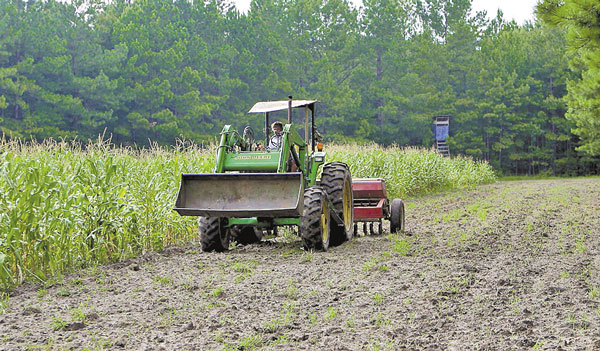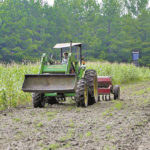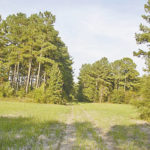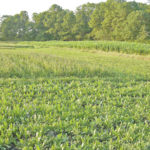
Where legal, most deer hunters elect supplemental feeding, usually with corn, over renewable, cultivated food plots. It’s a fact that feed corn has doubled in price over the past few years. In fact, corn alone contains little nutritional value and offers only marginal benefits for wildlife, regardless of how much animals have a taste for the sweet, carbohydrate-rich golden nuggets.Food plots reign supreme and offer deer protein-rich resources with undeniable benefits increasing body mass and boosting antler growth. Total food-plot area on a farm is often limited to insignificant acreages at each site and across the entire tract. Food plots should be large enough and plentiful across the landscape to be considered beneficial.
Eastern forestry practices have converted a significant portion of the landscape into intensively managed pine plantations. Although they offer wildlife browse and some native foods during the various stages of growth, overall, these plantations are deficient in providing the necessary nutrients and the volume for wildlife. Tracts dominated with pine monoculture over natural-mixed stands of hardwood and pine need the areas fully-dedicated to cultivating food crops.
Food plots should be at least 10,000 square feet or a quarter-acre, but the bigger the better. Food plots should cover at least five percent of the total land cover. For example, a 500-acre tract should have 25 acres dedicated to food-plot production. In addition, plots should be scattered throughout the property and not all in one large field. Five percent of the land cover dedicated to food plots will secure nutrients for the local deer population and will lure others onto the property as well. Small plots generally will get consumed quickly, only serving as a temporary food source.
With spring at hand, the warm-season planting season is approaching, and planting adequate acreages is critical. While fall plantings have their importance in the annual nutrient budget, summer food plots provide the nutrients when they are needed the most. The spring and summer seasons bring many native browse species for deer, but most tracts lack the abundance of native plants with the required nutrient composition during the critical time of need. Summertime food plots provide supplemental nutrition for does nursing newborn fawns and bucks growing thick antlers. Summertime strategic plantings provide the herd with nutritious and protein-rich forage preferred for growing big, healthy animals.
When increasing the size of plots, the shape of the plots should be considered. As deer are an “edge” species, irregular margins are preferred to create the most edge possible. But the irregular shape preferred should not take away too much from the overall size of the plot. Finding a mix of irregular edge and still maximizing the acreage is preferred.
As an important note, increasing plot size and abundance on the property is preferred, but only plant the amount of acres that can be adequately maintained with soil treatments, fertilization, and overall care. Five percent is recommended, but if the manager can only handle two percent of the land effectively, two percent of rich crops is much more preferred than five percent of poor food plots with little value.
Widen narrow plots and cascade edges
Many food plots are constructed as long, narrow lanes on the edges of wood lines or on old roadbeds. These narrow lanes offer extensive edge and a good shooting lane for the fall hunting season, but often they have developmental issues. Most food-plot species thrive on full sunlight. Narrow plots often constrict the exposure to full sun, crippling the potential for the planted seed.
Often these narrow food plots are created along wooded borders with overhanging limbs further shading the developing food plot crops. Large hardwoods adjacent to food plots have extensive root systems that extend into the area intended for cultivation. The roots, leaf litter, and other litter will alter the acidity of the soil, offsetting the pH and eventual uptake of other nutrients into food-plot crops.
These narrow plots should be widened or bubbled out every few hundred feet, creating narrow pathways — former food-plot width — between each bubble, resembling a pearl necklace. These wide areas allow for adequate sunlight penetration, more edge and essentially a more developed forage component. The narrow bottlenecks will provide deer with a sense of protection as well. Although the entire plot may not have 100-percent visual sight coverage from the deer stand, a shooting lane will still be present along the former narrow plot. The increased acreage and available food will sustain a larger group of deer for a longer period.
As a note, creating more edge can potentially create more shade on these edges where the food plots seeds are germinating and trying to grow. Multi-level edges are preferred along the edges of established food sources. The height of the vegetation edges should cascade from high to low as the adjacent vegetation approaches the edge of the food plot. This variable strata offers a variety of tree, shrub, and vine species to thrive with available forage within reach. The cascading-edge effect can be created by alternating mowing practices in strips from outside in, with the strip closest to the food plot maintained the most frequently. Multi-level edges discourage shade-producing trees from flourishing on the food-plot margins. These altered edges allow deer to enter the food plot at ease feeling a sense of security.
Planting season is here
All warm-season food-plot species essentially can be planted as soon as the soil temperature reaches 70 degrees. Most spring plantings will germinate with soil temperatures ranging from 55 to 65 degrees. As a rule of thumb often respected by many commercial farmers in the south, do not plant until after Good Friday to avoid the dangers of a killer frost at the tail end of winter.
“The best 4-week period to plant summer food plots is the last two weeks of April through the first two weeks of May,” said Joe Hamilton, director of education and outreach for Quality Deer Management Association. “Getting summer food plots established before late May allows the roots systems to get a foothold into the soil to take advantage of the available soil moisture. Planting any later often results in extreme competition with grasses and other weeds.
Fortunately, deer are not too choosy when it comes to food-plot species. As for most wildlife, they instinctively hone in on protein-rich crops but cannot resist the sweet flavor and texture of some of the high-carbohydrate crops that mature in the fall, such as corn. Soil composition and moisture level generally determines which crops are best suited for the site. Soil testing, site evaluation, and past year’s successes or failures should be used as a guide for determining the planting prescription.
All available food-plot crops are loaded with protein and critical nutrients beneficial to deer and other wildlife. With the exception of corn at seven percent, all popular summertime food-plot mixes with components of brassicas (e.g. Lab Lab) and legumes including soybeans, peas, and peanuts are loaded with highly digestible protein from 15 to 30 percent. While the majority of food-plot species prefer pH conditions approaching neutral, some plants such as Lab Lab thrive in acidic, sandy, dry sites when others would parish.
Seed mixes can be viewed in two different ways. Specifically, the seeds can be bundled together and planted homogeneously, or single seeds can be planted in groups of rows being alternated throughout the plot. Diverse plantings are definitely recommended but should be grouped accordingly to create the best conditions for individual growth and overall plot productivity. Seeds maturing with a low height can be combined in the hopper on select rows, and higher-maturing plants should be loaded together on opposite alternating rows. Generally, the higher plant species mature at a later date than the lower-growing plants, offering continued production and season-long food availability. In addition, the plot can be planted over a 3- to 4-week period offering maturing crops throughout the growing season.
The higher-growing crops such as, corn, millet and soybeans, in some cases will serve as cover, breaking up the large, expansive food plots. These areas provide deer and other wildlife a sense of security when traveling and feeding within the plots. Large round or square plots greater than three acres must have strips of high crops or cover breaks throughout to offer protection.
The goal of warm-season food plots is to provide a season-long nutrient-rich food source to serve the deer on the property. Using these techniques will benefit the deer and other wildlife when the animals require these resources the most.







Be the first to comment